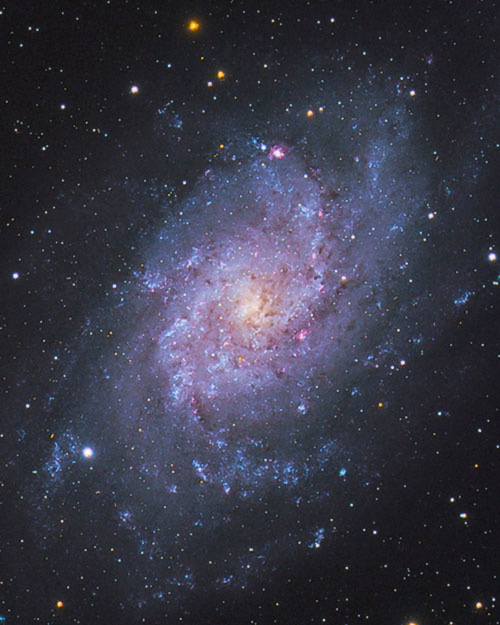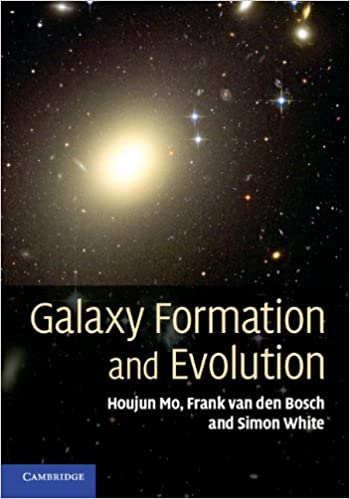Types of Galaxies
There are four distinct types of galaxies in the universe, elliptical, spiral, barred spiral, and irregular. Although these are the four main types, there are various types of galaxies and the way in which they are classified is by their shape.
A galaxy is a cluster of stars, gas, and dust that are kept together by the force of gravity. Within galaxies, there are also planets, black holes, moons, comets, and dark matter.
For example, the Milky Way, the solar system in which we reside, is classified as a barred spiral galaxy because of its general spiral shape accompanied by a bar and disk of stars at the center.
The other general classifications of galaxies include spiral galaxies, elliptical galaxies, and irregular galaxies. This shape classification of galaxies was created by Edwin Hubble in 1926 which he laid out in a diagram called the Hubble Tuning Fork, because of the diagram’s resemblance in shape to a tuning fork.
If you want to see some of the most incredible galaxy photos ever taken, be sure to visit the Hubble Space Telescope Image Archives: Galaxies.
Over the years I have photographed several galaxies from my backyard using my camera and telescope. To accomplish these detailed galaxy portraits, I take long-exposure images using a monochrome camera on an equatorial telescope mount.
The following image of the Whirlpool Galaxy is one of my favorites.
The Whirlpool Galaxy in Canes Venatici. Photo by Trevor Jones.
Spiral Galaxies
Named for their shape, spiral galaxies are the most common type of galaxy in the universe. Of all the known galaxies in the universe, 77% of them are classified as spiral galaxies.
These types of galaxies are classified by their 3 main components – a disk, bulge, and halo. The bulge is housed at the center of the galaxy. It is spherically shaped, and only contains old stars.
The disk component is both the shape of the galaxy and where new stars form in the galaxy. The halo is located on the outer edge of the galaxy. Similarly to the bulge, the halo is comprised of clusters of old stars which are known as globular clusters.
The Triangulum Galaxy. Photo by Trevor Jones.
Typically, the new stars form at the “arms” of the disk, however, when this type of galaxy does not have arms it is referred to as lenticular, or S0.
Regular or standard spiral galaxies are typically notated as S or SA. For both spiral and barred spiral galaxies, after the initial notation of the broad classification, there is a more specific classification noting the tightness of the spiral.
This more specific notation is the letters ‘a’, ‘b’, ‘c’, ‘d’, and so on where ‘a’ represents the tightest spiral.
Galaxy Type Chart (Tuning-fork-style diagram of the Hubble sequence) (Wikipedia)
There are many beautiful examples of spiral galaxies in the night sky. One of the best spiral galaxy examples in the Andromeda Galaxy.
Other than the Large and Small Magellanic clouds that are only visible from the southern hemisphere, the Andromeda Galaxy is the brightest galaxy you can see with your naked eye. To the unaided eye, this spiral galaxy appears as a smudge of light in the Andromeda constellation.
Through astrophotography, we can reveal much more of the galaxy structure, including the outer arms containing bright nebula regions. A camera’s sensor can record much more detail in a long-exposure image than our eyes could ever see visually.
The Andromeda Galaxy. Photo by Trevor Jones.
Lenticular Galaxy
Briefly elaborating, S0 galaxies are like a combination between a spiral galaxy and elliptical galaxy because of the bulge and disk that they do have, like spiral galaxies, but they do not have a spiral-like structure.
A lenticular galaxy is a type of galaxy intermediate between an elliptical galaxy and a spiral galaxy. This designation is according to the galaxy morphological classification scheme.
Lenticular galaxies are large-scale disc galaxies that do not have large-scale spiral arms. They have minimal ongoing star formation, as they have used up or lost their interstellar matter. As shown in the Sombrero Galaxy image below, they often retain a significant amount of dust in their disks.
The Sombrero Galaxy. Photo by Trevor Jones.
Barred Spiral Galaxies
Although similar to spiral galaxies, barred spiral galaxies differ in their shape slightly. Rather than just being spiraled from the nucleus like ordinary spiral galaxies, these have a ‘bar’ of matter running through them2. From the ends of this ‘bar’ the arms emerge.
This middle bar with the two arms extended from the ends of the bar causes barred galaxies to be shaped similarly to the letter ‘S’. Other than this major difference, barred spiral galaxies and typical spiral galaxies are essentially the same. Just like typical spiral galaxies, barred spiral galaxies contain a disk, bulge, and halo.
NGC 1300. NASA APOD June 11, 2020.
According to Hubble Tuning Fork, barred spiral galaxies are notated as SB rather than just S or SA as typical spiral galaxies are. Additionally, as noted earlier, the Milky Way is a barred galaxy!
But this went unnoticed by astronomers for a while compared to other galaxies because of the smaller bar of the Milky Way compared to other barred galaxies.
Some other examples of barred galaxies include NGC 1300 and NGC 1365.
NGC 1300 and NGC 1365 are only 60 million light-years from Earth which is close enough to be seen by telescope.
Because of their close proximity to Earth, both of these galaxies are pieces of two different constellations. NGC 1300 is a part of the constellation Eridanus and NGC 1365 is a part of Fornax.
Elliptical Galaxies
These elliptical galaxies are classified by their ovular shape and lack of central bulge. In contrast to their name, however, sometimes these galaxies are rather circular.
The stars and gasses in these types of galaxies are spread fairly evenly throughout, however, the center is still the brightest area. Additionally, elliptical galaxies do not contain many new stars. Rather, these galaxies are comprised of old, low mass stars.
At the center of an elliptical galaxy is typically a black hole. Compared to a barred spiral or typical spiral galaxy, in an elliptical galaxy there is a black hole where the bulge of old stars should be. This black hole may be part of the reason why new stars do not form often in elliptical galaxies.
NGC 3610. ESA/Hubble & NASA, Acknowledgement: Judy Schmidt
Because the central black hole of elliptical galaxies likely consumes the dust and gas necessary for new star formation, the materials necessary to make these new stars are not abundant in elliptical galaxies.
The notation for elliptical galaxies is E. Unlike the additional spiral tightness classification of barred and typical spiral galaxies, elliptical galaxies have a more specific classification of the numbers 0 through 7.
The 0 represents the most round elliptical galaxy and 7 means that the galaxy is very ovular.
Irregular Galaxies
As the name implies, irregular galaxies are all quite unique. Each irregular galaxy does not have a size or shape that is what we know as ‘regular’ or ‘normal’. These do not have any previously discussed components, such as a bulge, disk, or arms, that other galaxies are known to have.
According to NASA, the uniqueness of irregular galaxies may be because of interactions they could have had in the past with other, neighboring galaxies.
Irregular Galaxy NGC 55. NASA APOD, September 21, 2018. Martin Pugh.
Although there is nothing typical, symmetrical, or ordinary about irregular galaxies, there are two distinct types: IrrI (Irr1) and IrrII (Irr2). IrrI tend to have regions with an abundance of hydrogen gas as well as young stars.
In contrast, IrrII is extremely dust abundant which makes seeing the stars within this type of galaxy incredibly difficult.
Formation
Clusters and clouds of stars and dust making their way through the universe are thought to be the very beginnings of galaxy formation. As these groupings make their way closer together, gravity begins to play a role.
It is thought that once close enough, gravity will force together groups of stars and dust into a much larger entity.
Galaxy Formation and Evolution. Houjun Mo, Frank van den Bosch, Simon White.
The way in which different types of galaxies are formed is dependent upon the interactions of each component during the original formation of the galaxy.
For example, collisions of space masses are likely to occur which may then force certain pieces to the outer edges of the galaxy. This interaction would then potentially form the arms of a spiral galaxy.
List of Naked Eye Galaxies
Certain galaxies are so bright that you can observe them visually with the unaided eye. This means that you do not need a telescope or binoculars to the galaxy, you just need to look up at the right time and place. Light pollution can spoil the view, so be sure to attempt viewing these naked-eye galaxies from a dark-sky location.
Here is a list of the brightest galaxies you can observe with the naked-eye under clear, moonless conditions.
- Large Magellanic Cloud (Magnitude 0.9)
- Small Magellanic Cloud (Magnitude 2.7)
- Andromeda Galaxy (Magnitude 3.4)
- Triangulum Galaxy (Magnitude 5.7)
- Centaurus A (Magnitude 6.84)
- Bode’s Galaxy (Magnitude 6.94)
- Sculptor Galaxy (Magnitude 7.2)
I have personally observed the 2 brightest northern hemisphere galaxies from a dark sky location (Bortle Scale class 2). The Andromeda Galaxy and Triangulum Galaxy were noticeable “smudges” in the night sky.
In the picture below, you’ll notice the Andromeda Galaxy is visible to the upper right of the image. Although this is a long-exposure photograph, this is a useful (exaggerated) representation of what you can expect to see under pristine skies.
The Andromeda Galaxy is visible to the naked eye from a dark sky location.
Certain constellations, such as Virgo, contain galaxy clusters. The Virgo Cluster is a galaxy cluster found in the constellations Coma Berenices and Virgo.
The cluster’s center is located approximately 53.8 million light-years away from the solar system, at the center of the Virgo Supercluster, the larger cluster of galaxies that also contains the Local Group, which in turn includes the Andromeda Galaxy and the Milky Way.
The Virgo Cluster contains about 1300 galaxies, possibly even up to 2000. The image below highlights a particularly handsome cluster of galaxies, known as Markarian’s Chain.
Markarian’s Chain (Trevor Jones) The Virgo Cluster of Galaxies.
Types of Galaxies (Video)
In the following video, the author explains how galaxies are categorized according to their apparent shape. The shape of the galaxy gives astronomers clues as to the age and types of stars found within it.
This is an excellent summary of the different types of galaxies in the universe.











